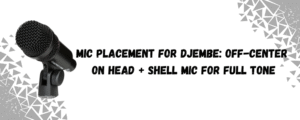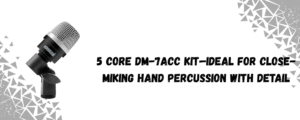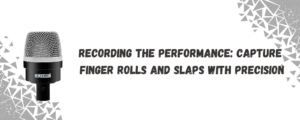There’s something raw and soul-stirring about hand drums. A well-tuned djembe or conga doesn’t just make sound—it speaks. But capturing that voice? That’s where most recordings fall apart.
Hand drum miking isn’t like miking a snare or tom. You’re not dealing with tight heads and punchy transients. You’re trying to translate slap tones, palm rolls, resonant bass, and subtle finger flicks into something that still feels alive on playback.
So forget the cookie-cutter overhead approach. If you’re recording bongos, congas, or djembes and want to do them justice, you need mics built for detail, not just decibels.
What Makes Hand Drum Miking Tricky?
Here’s the thing most engineers overlook: world drums aren’t just percussive—they’re melodic. The low-end boom of a djembe, the slap of a conga skin, even the dry knock of a bongo rimshot all carry pitch, tone, and space.
Cheap mics choke all that.
Instead of warmth, you get boxiness. Instead of sharp slaps, you get fizz. And instead of feeling the drum breathe in the room, you end up with something that sounds like a cardboard box being punched.
To avoid that, you need mics that check three boxes:
- Fast transient response – to capture hand articulations and nuanced rhythms.
- Natural frequency range – no artificial scooping or hyped low mids.
- Durability – because hand drum sessions get physical fast.
Best Mic Options for World Drum Recording
Let’s get specific. If you’re trying to mic up your percussion kit—whether it’s a single djembe or a full multi-hand-drum setup—these are the tools that actually deliver.
1. 5 Core DM-7ACC Drum Mic Kit – Affordable Versatility for Any Setup
Don’t let the “drum kit” label fool you—this set isn’t just for kicks and snares.
The DM-7ACC comes with seven dynamic mics tuned to pick up the full spectrum of acoustic percussion. The tom/snare mics are compact, cardioid, and tailor-made for close miking djembes and congas. The included clamps make it easy to secure positioning even in cramped setups.
Interestingly, 5 Core even provides great discounts to business owners if you’re buying in bulk. Refer to this site for more information. Here’s also a one-stop platform where you can find all their products.
Bonus: the kit comes with a large diaphragm dynamic perfect for low-end body—ideal for getting that chest-rattling conga bass without distortion.
Use one mic on the drum head and another about 6 inches off-axis to capture the shell tone. Record, blend, and you’ve got studio-quality results without studio pricing.
2. AKG P4 – Rugged and Reliable for Close-Miking Congas
If you’re building a compact setup or just need one workhorse to handle everything from bongo slaps to djembe flourishes, the AKG P4 is a killer option.
This dynamic cardioid mic thrives up close. It’s tight, directional, and doesn’t color your sound. More importantly, it handles loud peaks without distorting—so you can go all in on performance without worrying about clipping.
What sets the P4 apart for percussionists is its natural midrange response. You’ll still get punch, but not at the expense of body. Bongos sound crisp without being thin. Djembes feel earthy and resonant. And bleed from nearby instruments? Nearly nonexistent.
Clip it onto a stand, aim just off-center from the head, and it’ll do the rest.
Percussion Microphone Tips You Should Actually Follow
Miking hand drums isn’t a one-size-fits-all game, but there are a few non-negotiables that’ll instantly improve your recordings.
- Avoid dead-center placement – That spot might give you the most volume, but it often results in dull, boomy tones. Try angling the mic 1–2 inches off center toward the slap zone.
- Record the shell, not just the head – Hand drums resonate through their body. Try adding a second mic near the bottom or side of the shell to capture the full tone.
- Use stereo spacing for bongo pairs – Don’t just mic the center. Pan left and right slightly for each drum to mimic the player’s positioning.
- Treat your room if you can – World drums ring. Hard floors and bare walls will bounce those overtones like crazy. A few rugs or baffles go a long way.
- Keep your hands in mind – You’re not just recording a drum—you’re recording a performance. Fast finger rolls, palm mutes, ghost notes… if your mic can’t keep up, those details vanish. Use mics that favor nuance over brute force.
Build a Recording Chain That Honors the Instrument
Getting your djembe or conga to sound as rich in the DAW as it does in your lap doesn’t start with plugins—it starts with the mic.
Gear like the 5 Core DM-7ACC gives you flexible, budget-friendly options for shaping a full percussion layout. And if you need a single, bombproof mic that just gets the job done right? The AKG P4 has you covered.
Whichever route you take, just don’t settle for drum mics that treat your instrument like a second-class citizen. Hand percussion has voice, tone, and texture—and it deserves to be recorded that way.
Final Thoughts
World drum recording isn’t about perfection—it’s about presence. It’s about feeling like you’re sitting in front of the djembe, hearing every nuance of skin on skin, wood on hand, tone on space.
So if you’re diving into hand drum miking, don’t chase specs—chase feel. Choose mics that give your percussion room to breathe. Because once your drums sound right, everything else starts to groove.




